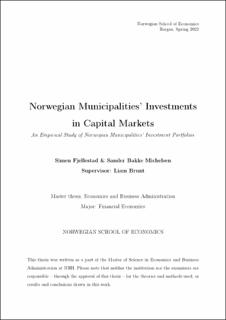Norwegian Municipalities' Investments in Capital Markets: An Empirical Study of Norwegian Municipalities’ Investment Portfolios
Abstract
Unfamiliar to many, Norwegian municipalities manage substantial investment portfolios
totaling 35 billion NOK (3.7B USD). In this thesis we investigate what characterizes
Norwegian municipalities' investments in capital markets as well as how they have
performed in equity markets. We start by establishing a general overview consisting of
assets under management and asset allocation for all municipalities. We observe that
total investments in capital markets have increase by 30% since 2003, whereas the largest
growth has been in stocks and shares. This paper reveals that investments in stocks and
shares have doubled in the last 10 years. From a sample of 37 municipalities, we find that
the most prominent drivers of municipal investment in capital markets are gross income
per capita and population size.
Further, we find that the average portfolio consists of 70% fixed income and 30% equity,
indicating that Norwegian municipalities generally are risk averse. However, we find that
there are variations among them, whereas a municipality with higher-income population,
higher assets under management-to-assets and income from power companies is less risk
averse. When evaluating the municipalities' equity performance, we use the Carhart
four-factor model. At a 5% significance level, 2 out of 27 municipalities are achieving
positive excess returns, respectively Vennesla and Sokndal. In contrast, Volda is delivering
negative abnormal excess returns. However, when applying a persistence analysis, we
reveal that there seems to be no evidence of superior skill, implying that the positive
(negative) abnormal returns are due to luck (bad luck).
